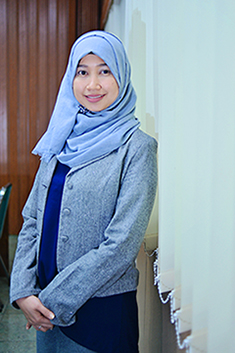Study of Growth Curve of Lactobacillus plantarum FNCC 0026 and Its Antibacterial Activity
Downloads
Background: Lactobacillus plantarum is one of the lactic acid bacteria (LAB) with strong antibacterial activity. However, these bacteria show different growth for each strain. The turbidimetric bacterial growth curve approach is the most accurate, fastest, and most reproducible method for obtaining an overview of the bacterial life cycle. In addition, we also examined the antibacterial activity of each observation of the growth curve. Objective: The aim of the study was to determine the optimal incubation time with the highest biomass concentration and antibacterial activity of the Lactobacillus plantarum FNCC 0026. Method: Observations of optical density (OD) values "‹"‹were performed simultaneously on 10 points of Lactobacillus plantarum FNCC 0026 and performed every 12 hours. Antibacterial activity tested against Staphylococcus aureus ATCC 25923 and Escherichia coli ATCC 8739. Result: The Lactobacillus plantarum FNCC 0026 fermentation broth showed the highest OD value and antibacterial activity after 30 hours of incubation. The maximum diameter of the inhibition zone against Staphylococcus aureus ATCC 25923 and Escherichia coli 25923 were 17.08 ± 0.51 mm and 16.83 ± 0.54 mm. Conclusion: The results showed that the antibacterial activity had a linear relationship with the concentration of bacteria. In the Lactobacillus plantarum FNCC 0026, the optimum cultivation time is in the lag phase (24 – 30 hours).
Alteri, C.J., & Mobley, H.L.T. (2012). Escherichia coli physiology and metabolism dictates adaption to disverse host microenviroments. Current Opinion Micribiology, 15 (1), 3-9.
Daba, G. M., & Elkhateeb, W. A. (2020). Bacteriocins of lactic acid bacteria as biotechnological tools in food and pharmaceuticals: Current applications and future prospects. Biocatalysis and Agricultural Biotechnology , 28 (August), 101750.
De Vos, P., Garrity, G. M., Jones, D., Krieg, N. R., Ludwig, W., Rainey, F. A., et al., 2009. Bergey's Manual Of Systematic Bacteriology 2nd Ed. Athens: Springer.
Hernández-González, J. C., Martínez-Tapia, A., Lazcano-Hernández, G., García-Pérez, B. E., & Castrejón-Jiménez, N. S. (2021). Bacteriocins from lactic acid bacteria. A powerful alternative as antimicrobials, probiotics, and immunomodulators in veterinary medicine. Animals , 11 (4), 1-17.
Isnaeni, Andri A, and Muhammad.Y. (2017). Validation of thin- layer-chromatography-bioatutographic method for determination of streptomycin. Jurnal Farmasi dan Ilmu Kefarmasian IndonesiaI., 4 (1): 32-38.
Kumar, L. M., Saad, W. Z., Mohamad, R., & Rahim, R. A. (2017). Influence of biofilm-forming lactic acid bacteria against methicillin-resistant Staphylococcus aureus (MRSA S547). Asian Pacific Journal of Tropical Biomedicine , 7 (12), 1107-1115.
Layus, B. I., Gerez, C. L., & Rodriguez, A. V. (2020). Antibacterial Activity of Lactobacillus plantarum CRL 759 Against Methicillin-Resistant Staphylococcus aureus and Pseudomonas aeruginosa. Arabian Journal for Science and Engineering , 45 (6), 4503-4510.
McBirney, S.E., Trinh, K., Wong-Beringer, A., Armani, A.M. (2016). Wavelength-normalized spestroscopic analysis of Staphylococcus aureus and Pseudomonas aeruginosa growth rates. Biomedical Optics Express,7 (10), 4034-4042.
Rahman, N.A., Halim, M.R.A., Mahawi, N., Hasnudin, H., Al-Obaidi, J.R., Abdullah, N. (2017). Determination of the use of Lactobacillus plantarum and Propionibacterium freudenreichii application on fermentation profile and chemical composition of corn silage. BioMes Research International, ID 2038061, 1-8.
Rezvani, F., Ardestani, F., Najafpour, G. (2017). Growth kinetic models of five species of Lactobacilli and lactose consumption in batch submerged culture. Brazilian Journal of Microbiology, 48, 251 – 258.
Shim, Y. H., Lee, S. J., & Lee, J. W. (2016). Antimicrobial activity of lactobacillus strains against uropathogens. Pediatrics International , 58 (10), 1009-1013.
Seddik, H.A., Bendali, F., Ganeel, F., Fliss, I., Spano, G., Drider, D. (2017). Lactobacillus plantarum and its probiotic and food potentialities. Probiotics & Antimicro. Prot., 9, 111-122.
Slizewzka, K., Chlebicz-Wojcik, A. (2020). Growth kinetic of probiotic Lactobacillus strain in alternative, cost-efficient semi-solid fermentation medium. Biology, 9 (432), 1-13.
Wang, C., & Li, S. (2015). Functional foods and nutraceuticals, Potential role in human health. In D. Ghosh, D. Bagchi, & T. Konishi, Clinical aspects of functional foods and nutraceuticals (pp. 51-76). NW: CRC Press, Taylor & Francis Group.
Copyright (c) 2023 JURNAL FARMASI DAN ILMU KEFARMASIAN INDONESIA

This work is licensed under a Creative Commons Attribution-NonCommercial-ShareAlike 4.0 International License.
1. The copyright of this journal belongs to the Editorial Board and Journal Manager with the author's knowledge, while the moral right of the publication belong to the author.
2. The formal legal aspect of journal publication accessibility refers to the Creative Commons Attribution-Non-Commercial-Share Alike (CC BY-NC-SA), which implies that the publication can be used for non-commercial purposes in its original form.
3. Every publication (print/electronic) is open access for educational, research, and library purposes. In addition to the objectives mentioned above, the editorial board is not responsible for copyright infringement


.jpg)















